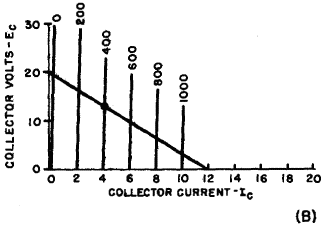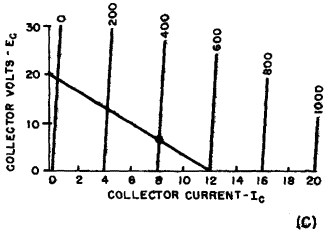| Transistor Basics is a free introductory textbook on transistors and their basic applications. See the editorial for more information.... |

|

Home  Transistor Amplifiers Transistor Amplifiers  The D-C Operating Point The D-C Operating Point  Self-Bias Self-Bias |
||






|
||
|
Self-BiasAuthor: Leonard Krugman
Fig. 5-3. Variation of operating point: normal case (A), lo Ico (B) high Ico (C) A simple method for establishing automatic control of the base bias requires the base bias resistor to be tied directly to the collector, as in Fig. 5-4. Thus, if the collector voltage is high (Fig. 5-3B), the base current is increased, moving the d-c operating point downward along the load line; conversely, if the collector voltage is low (Fig. 5-3C), the base bias current is decreased, moving the d-c operating point upward along the load line. The value of the selected base bias resistor is different in the self-bias case from that computed in the fixed-bias connection. For self bias, the resistor is tied to the collector voltage, which in this case is 10 volts. Then
Fig. 5-4. Self-bias operation.
The importance of temperature stability with respect to the d-c operating point cannot be taken lightly. One of the effects of a temperature rise is to increase the saturation current Ico, which, in turn, increases the collector dissipation. The increased collector dissipation increases the temperature, which increases Ico, and so on. Thus, poor temperature stability almost certainly will cause transistor burnouts, particularly if the transistor is operated near its maximum dissipation limit.
|
||
Home  Transistor Amplifiers Transistor Amplifiers  The D-C Operating Point The D-C Operating Point  Self-Bias Self-Bias |
||
Last Update: 2010-11-17





 ohms. The base bias resistor performs the double duty of determining the value of Ib and preventing those excessive shifts in the collector d-c operating point due to temperature change and transistor interchange. The principal limitation of self bias is that it still allows some variation of the d-c operating point, since the base bias resistor is fixed by the required operating point, and the stabilization produced by it is only a secondary effect. In addition, self bias also introduces a-c negative feedback which reduces the effective gain of the amplifier. Despite its limitations, however, self bias is very useful and works well in many applications.
ohms. The base bias resistor performs the double duty of determining the value of Ib and preventing those excessive shifts in the collector d-c operating point due to temperature change and transistor interchange. The principal limitation of self bias is that it still allows some variation of the d-c operating point, since the base bias resistor is fixed by the required operating point, and the stabilization produced by it is only a secondary effect. In addition, self bias also introduces a-c negative feedback which reduces the effective gain of the amplifier. Despite its limitations, however, self bias is very useful and works well in many applications.